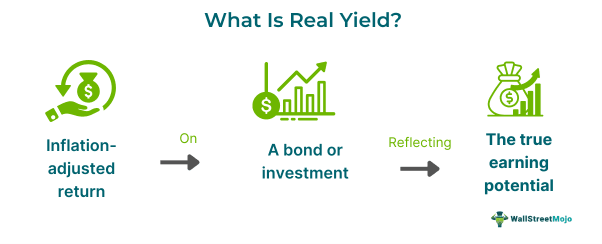Table of Contents
What Is Real Yield?
Real yield is the inflation-adjusted interest rate that describes a borrower's real cost of funds or a lender's real return rate. In other words, it is defined as an investor's bond return from the interest payments accrued after accounting for inflation, representing the investment's future purchasing power.

In theory, the real interest rate is calculated as the nominal rate of return minus the expected inflation rate. It is an essential financial indicator that explains what an investor is receiving from their investment after factoring in inflation. Investors and market researchers track and study real yield fluctuations to understand market returns.
Key Takeaways
- Real yield is the gap between nominal yield and inflation rate describing the investment return.
- The real interest rate can be either positive or negative, depending on the expected inflation rate.
- If the inflation rate is low, it means that investors have a better chance of earning good returns from holding an investment, defining high purchasing power.
- When the inflation rate is high, it decreases the real yield, which may bring it to a negative rate, which directly affects the investment return.
Real Yield Explained
Real yield is the interest rate that investors receive from their investments after adjusting for inflation. There are two types of yield: nominal and real. The nominal yield is the stated return on investment while it accounts for inflation. Inflation refers to the general rise in prices of goods and commodities over time. The real yield focuses on the investment's purchasing power relative to inflation, as market prices typically increase over time.
It indicates that if the inflation rate is higher than the nominal yield, the investor may not gain good returns from the investment because rising prices will erode the purchasing power of the returns.
A bond's real yield is determined by subtracting the expected inflation rate from the bond's nominal yield. This yield can be positive or negative depending on the rates. Bonds are generally held for long periods, and by the time they mature, market inflation may have increased prices, so understanding it helps investors decide if the bond will be beneficial.
The curve represents the gap between the nominal yield and the inflation rate, and it is helpful in deducing forward real interest rates. It can act as a brake on economic growth, slow profits, and negatively influence the stock market by impacting stock valuations, as valuation models use the real yield to assess future earnings.
How To Calculate?
Real yield, calculated using the formula Real Yield = Nominal Yield - Inflation Rate (expected or actual), represents the interest rate investors receive from their investments after accounting for inflation. This adjustment is crucial as it reflects the actual purchasing power of the investment returns.
The gap between the nominal interest rate and the prevailing or expected inflation rate derives from the actual investment pay rate. By adjusting for inflation, it provides a more accurate measure of an investment's profitability over time, considering that market prices typically rise.
Examples
Below are two examples: one is a calculation, and the other is from a piece from the world news.
Example #1
Suppose John had $99 and wanted to buy an expensive perfume. Instead, he decided to keep the money in a savings account, offering a nominal yield of 4% for nine months. The expected inflation rate is 9%. After nine months, John has $103.96 in his savings account, but due to inflation, the perfume now costs $107.91.
Using the formula:
Real Yield=Nominal Yield−Inflation Rate
4%−9%=−5%
This indicates that John's real yield was -5%, reducing his $99 purchasing power by $3.95.
In another scenario, if John kept the same $99 in a savings account for nine months at a 4% nominal yield, but the inflation rate was only 2%, the perfume's price after nine months would be $100.98, while the money in his savings account would grow to $103.96.
Using the formula:
4%−2%=2%
This time, John's real yield is +2%, increasing his $99 purchasing power. After nine months, he would have:
103.96−100.98=$2.98
This simple example demonstrates how it affects purchasing power. The same principle applies to bonds, stocks, and other financial instruments, although many other direct and indirect factors can influence these calculations.
Example #2
According to a Business Standard article, the real yield on 10-year inflation-protected Treasuries exceeded 2% for the first time since 2009, increasing by approximately six basis points from year-to-date lows near 1%. This rise marks levels not seen in over a decade as investors demand higher risk-free rates of return amid a resilient US economy.
The increase in real yields is driven by higher Federal Reserve policy rates and better growth expectations, with little change in breakeven inflation expectations. These factors suggest that US market yields may remain elevated for an extended period, ending the post-financial crisis era of ultra-low rates.
Real Yield Vs. Nominal Yield
The main differences between real yield and nominal yield are -
- Real yield is the inflation-adjusted interest rate. In contrast, nominal yield is the interest rate without factoring in the rate of inflation.
- The real yield draws a better picture of the purchasing power and actual return on investment. On the other hand, nominal yield only depicts the cursory look of investments.
- Real yield is also called real interest rate. In comparison, the nominal yield is also referred to as an annual percentage rate or APR.
- Real yield is more reliable and pursued than the nominal yield given in its inflation accounting.
